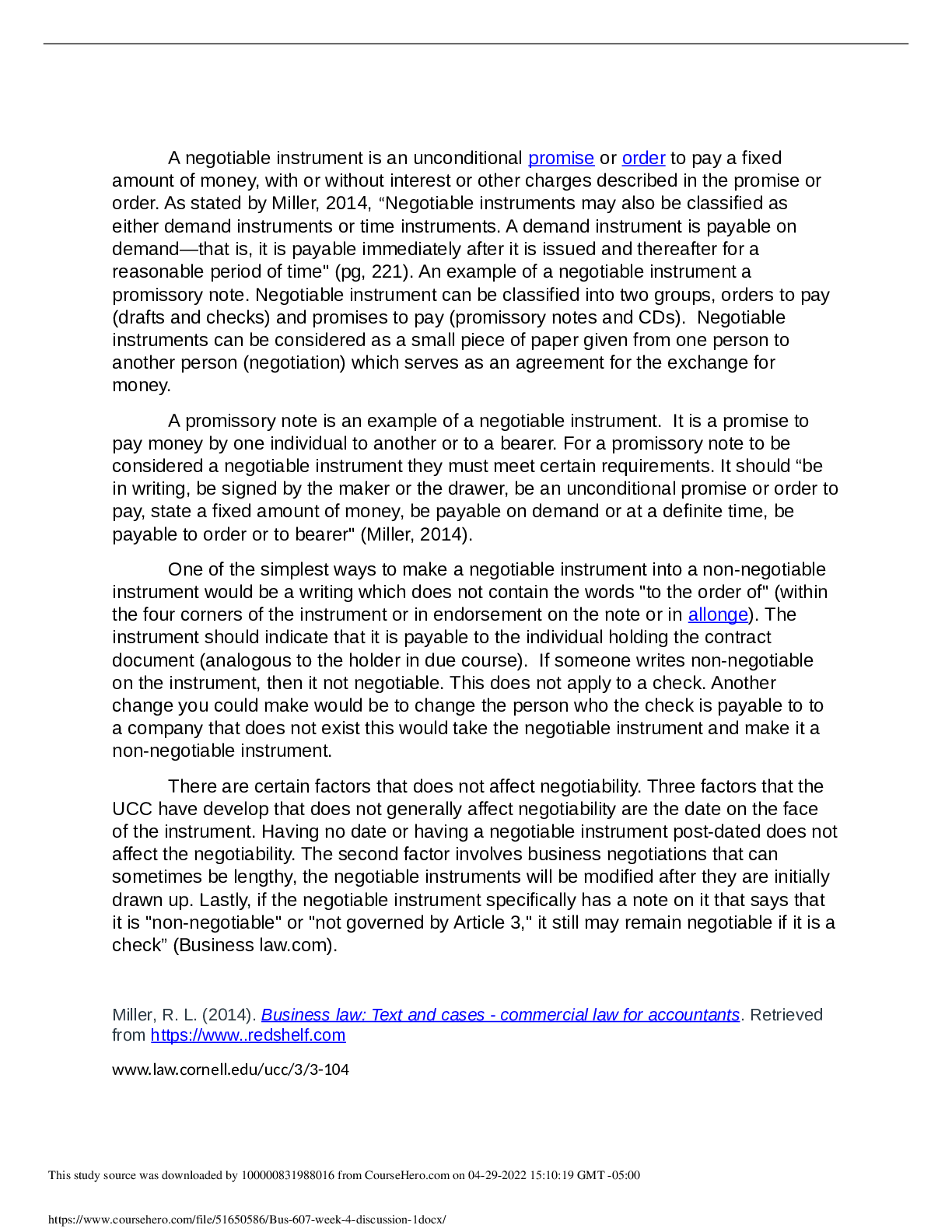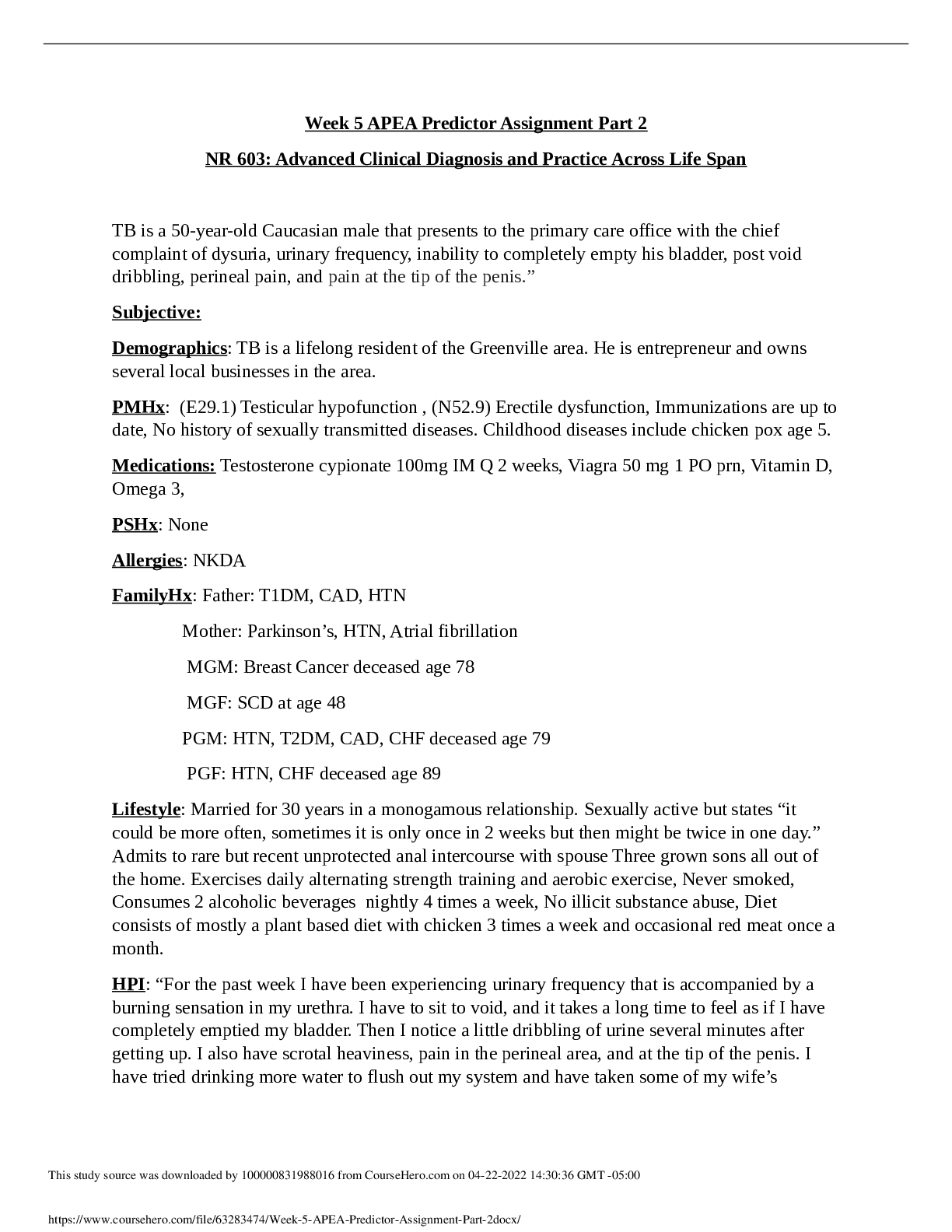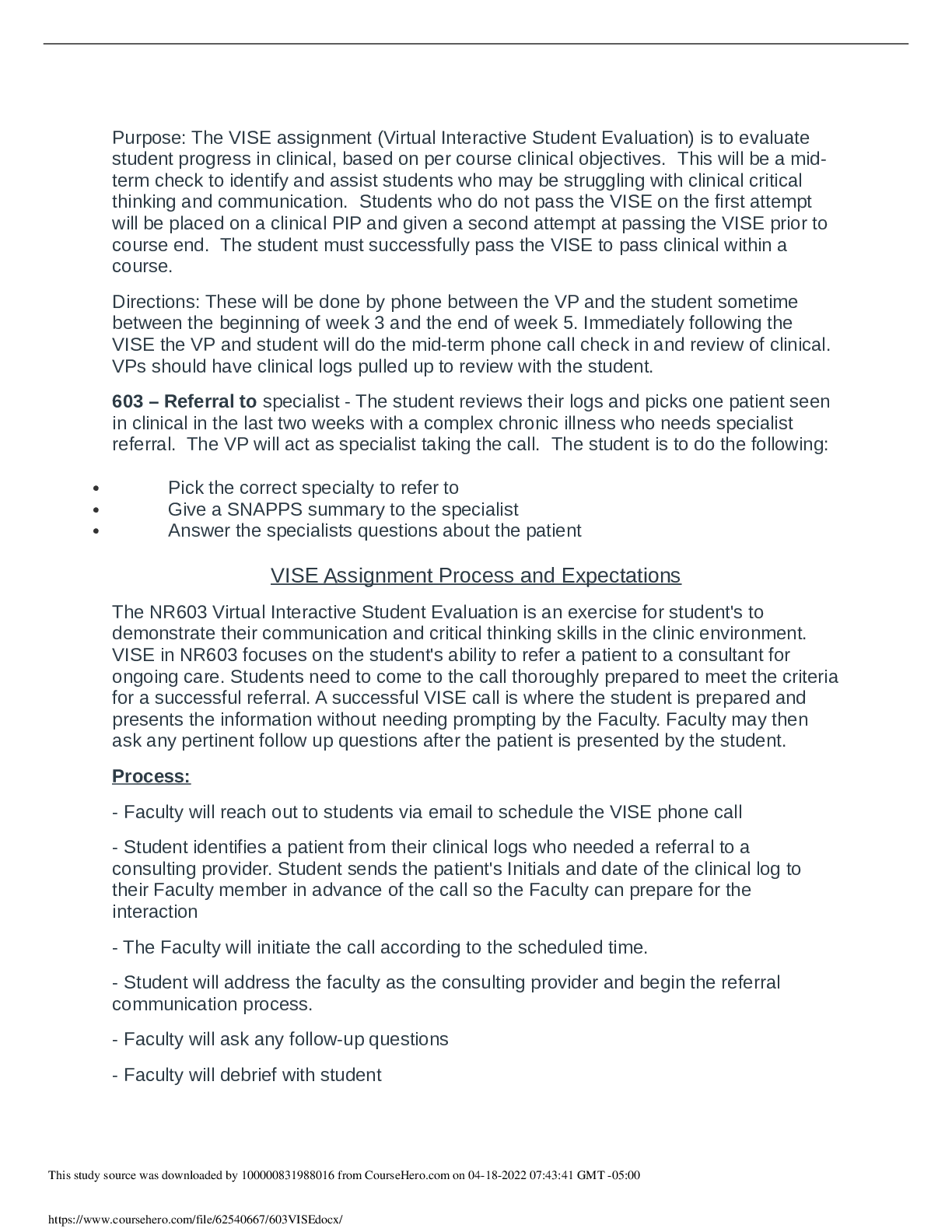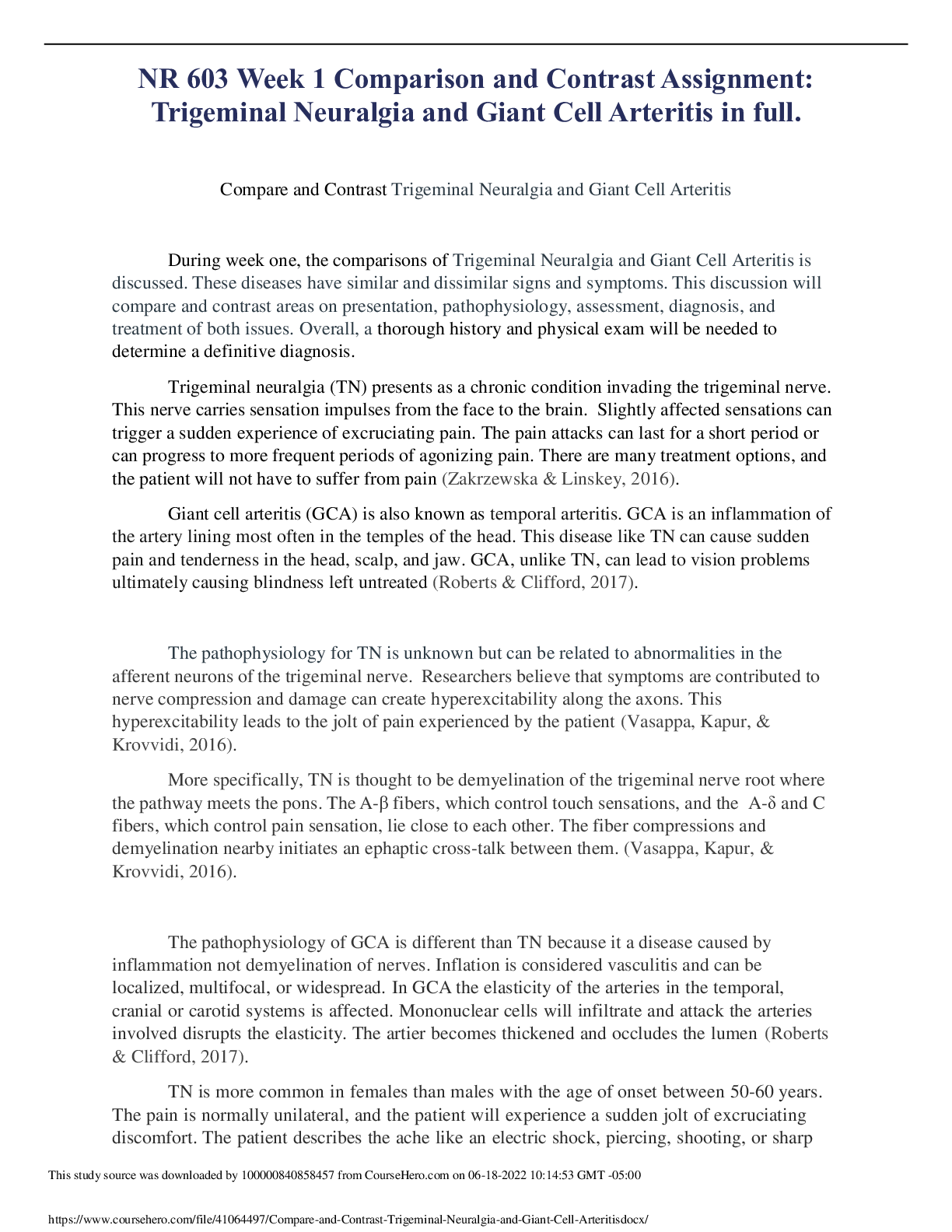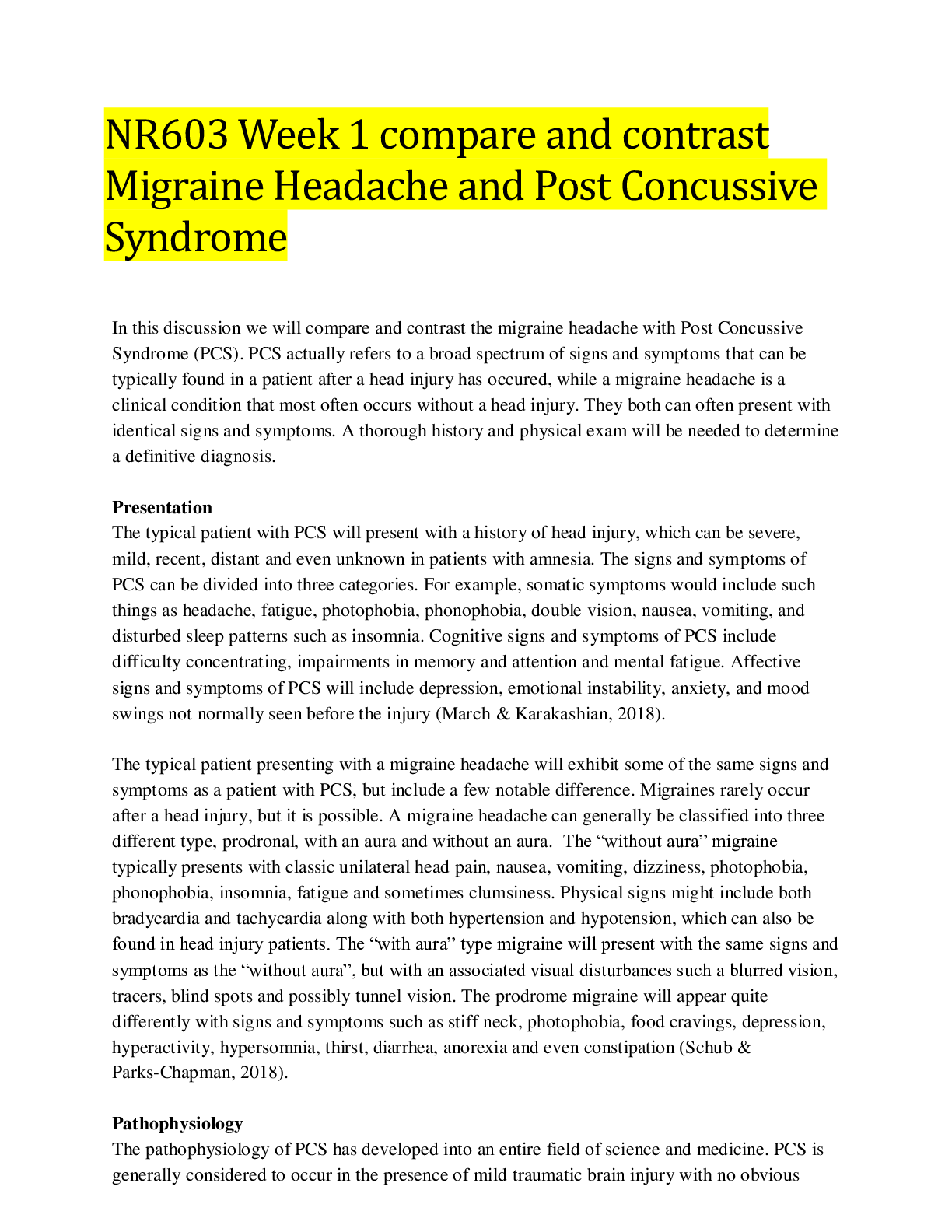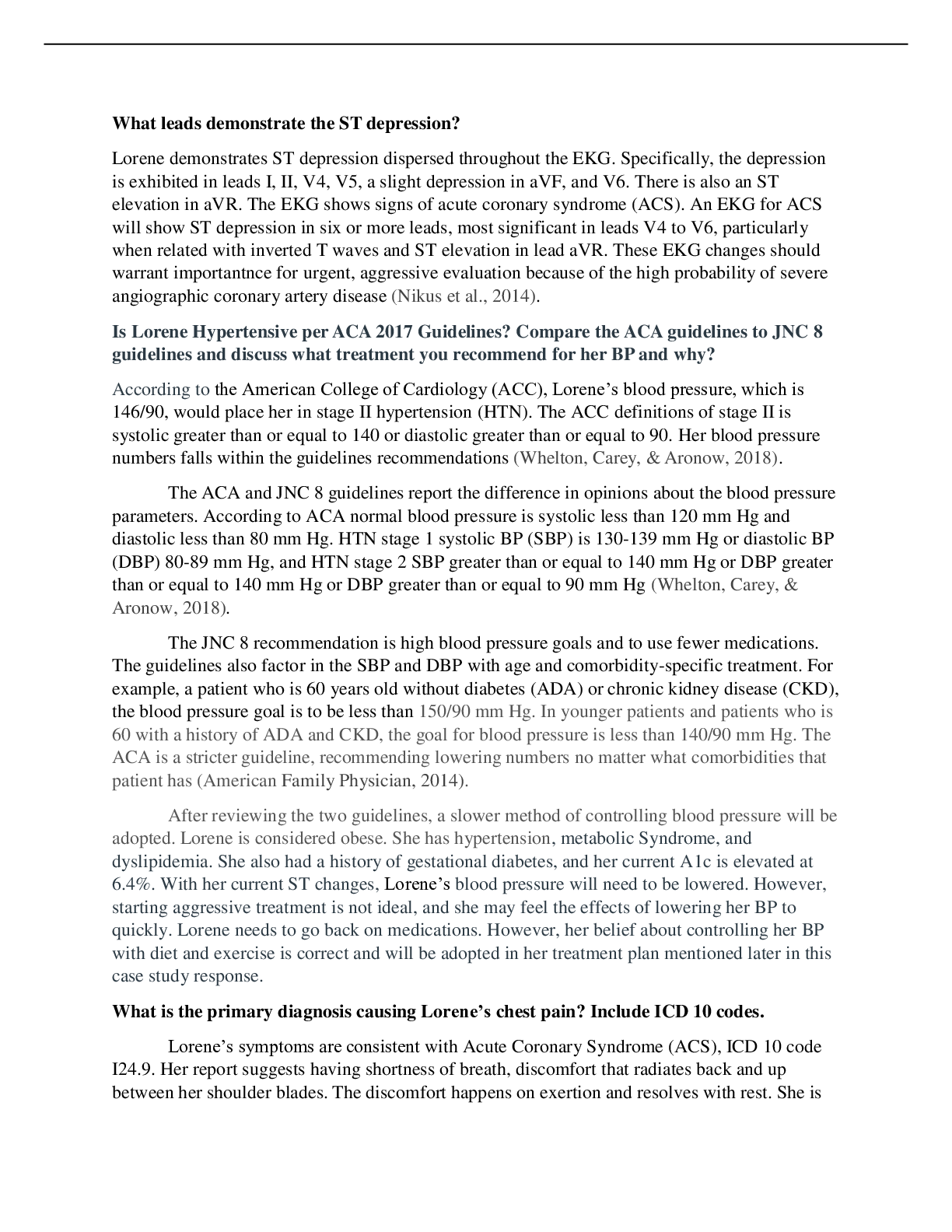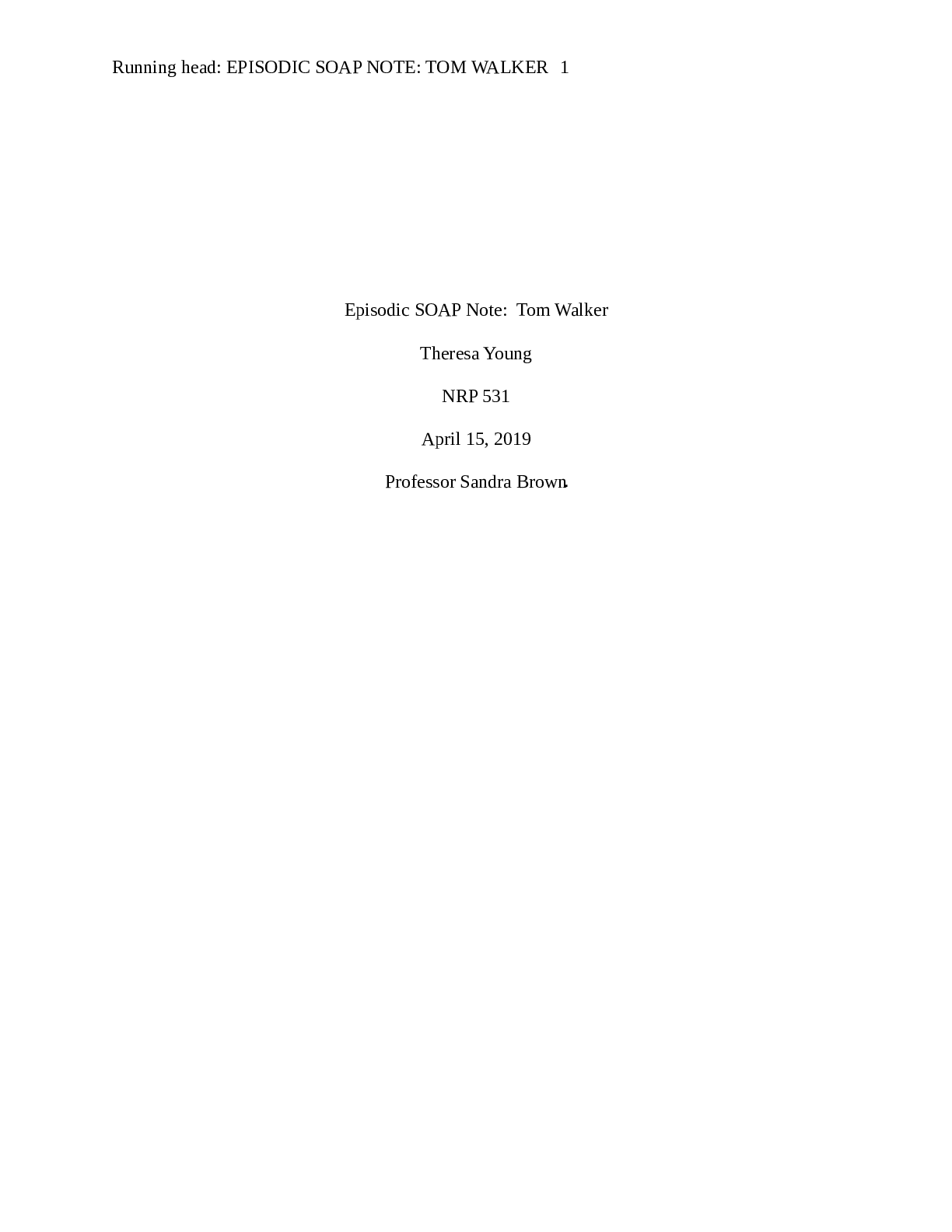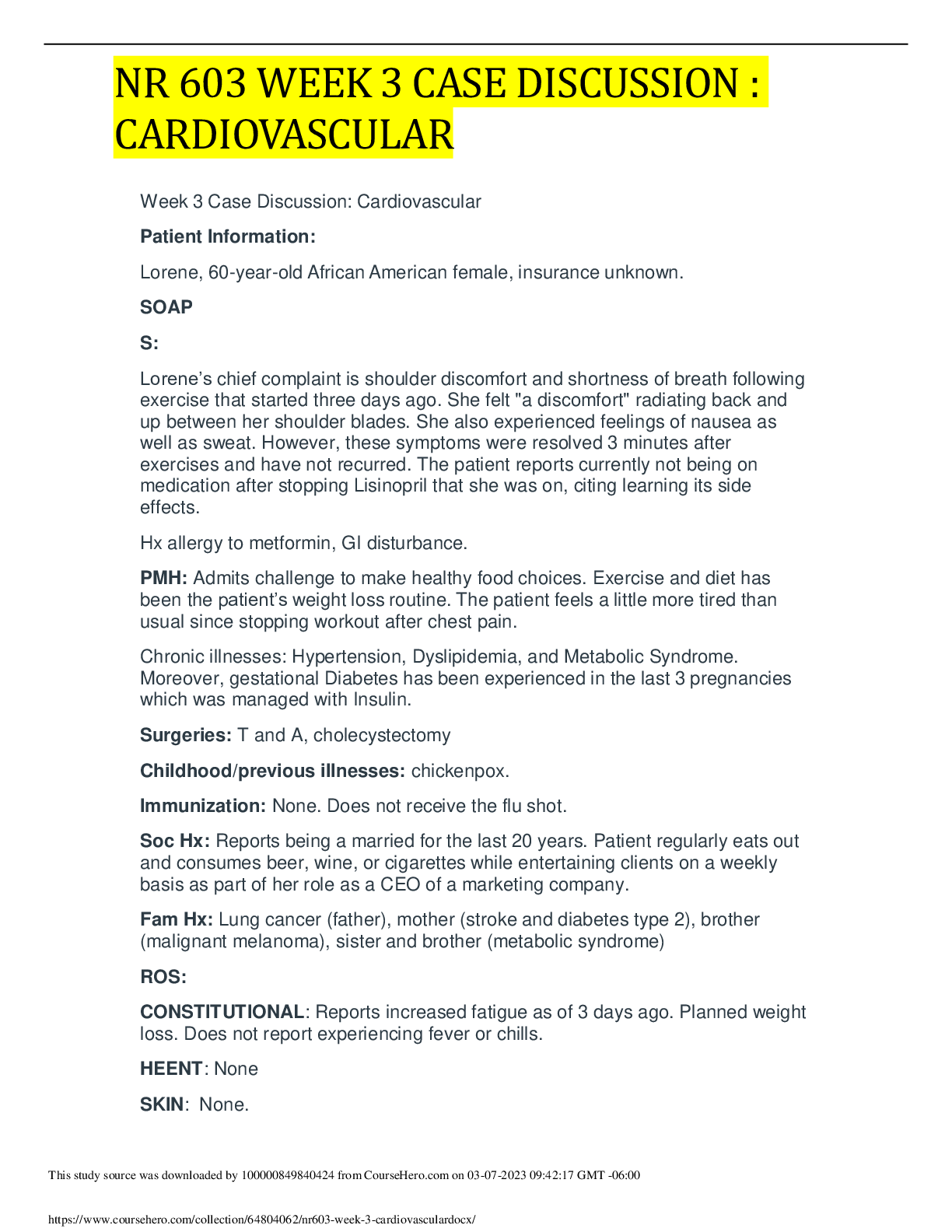*NURSING > DISCUSSION POST > Chamberlain College of Nursing - NR 603 Week 6 Mental Health Disorders Already Graded A. (All)
Chamberlain College of Nursing - NR 603 Week 6 Mental Health Disorders Already Graded A.
Document Content and Description Below
Include their actual chief complaint, demographic data, HPI, PMHX, PSHX, medications, allergies, subjective and objective findings without identifying the patient’s name. Dr. Deering and class, T... he following information is in regards to a patient with a mental health disorder: Subjective: Chief Complaint: Difficulty sleeping and fatigue HPI: D.W is a 32 year old female who presented to the office three weeks ago with complaints of difficulty sleeping and fatigue. She reported that it takes her several hours to fall asleep and that some nights she could not fall asleep at all. She stated that she spends a lot of time worrying about work deadlines and taking care of her family. She and her husband divorced a month ago, and she is currently taking care of her four-year old twin daughters with the help of her mother. She works as a human resources recruiter. She reports little interest in hobbies that she used to love, including playing golf and soul cycling. She states that she’s been having very low energy, tired, and difficulty concentrating in the last few weeks. She tries to do at least one social activity with her friends, but most nights she feels too tired. She also finds that social events with couples make her feel very sad and uncomfortable. She has not tried any prescription or over-the-counter medications. Current medications: Multivitamin and metoprolol 25 mg once daily Allergies: Pollen PMHx: Hypertension PSHX: Cesarean delivery in 2015 Social history: Divorced with four-year old twin daughters. Denies tobacco use or recreational drug use. Drinks three cups of coffee daily. Drinks one to two glasses of wine in one month. ROS: General: Denies fever, chills, or night sweats. Reports fatigue and inability to sleep in the past three weeks. Reports unintentional weight loss of 5 pounds in the last month. HEENT: Denies head trauma, visual loss, hearing loss, tinnitus, sore throat, or hoarseness. Neuro: Denies headaches, dizziness, seizures, vertigo, loss of balance, or incoordination. Cardiovascular: Denies chest pain, palpitations, or peripheral edema. Respiratory: Denies dyspnea, wheezing, shortness of breath, cough, or hemoptysis. Gastrointestinal: Reports decreased appetite in the last month. Denies nausea, vomiting, diarrhea, constipation, or abdominal pain. Genitourinary: Denies dysuria, nocturia, hematuria, or vaginal discharge. Currently on menstrual period. Hematologic: Denies easy bruising or bleeding. Psychiatric: Reports inability to sleep, difficulty concentrating, and excessive worrying. Denies a history of depression or family history of other psychiatric disorders. Denies hallucinations, delusions, or suicidal thoughts. Objective: Vital Signs: HR 92, BP 122/72, RR 16 (regular). Height: 5’5; Weight: 144 lbs General: D.W appears fatigue but is in no respiratory distress. She is awake, alert, cooperative, and dressed appropriately. HEENT: Head is normocephalic. No exudate noted in the eyes. No vision loss or blurred vision. Bilateral TMs are pearly gray. No hearing loss noted. Patent nares with no exudate. Moist and intact oropharynx. Neck is supple. No cervical lymph node tenderness and lymphadenopathy. Midline thyroid without enlargement and masses. Cardiovascular: S1 and S2 with regular rate and rhythm. No murmurs or rubs noted. Respiratory: Symmetric chest expansion. Unlabored respirations. Lung sounds clear bilaterally. No crackles or wheezes noted. Psych: PHQ-9 score is 14. Speech is clear. Able to express thoughts in a logical manner. Diagnostic or Lab results: Available lab results drawn last month during D.W’s annual physical: RBC 4.5 million/ mcL; Hgb 13.2 g/dL; HCT 37%; PLT 256,000; WBC 7,000 mc/L; Na 143 mEq/L; K 4.2 mEq/L; Mg 2.0 mEq/L; HCO3 24 mEq/L; BUN 10 mg/dL; Creatinine 0.7 mg/dL TSH: 2.31, Free T4 0.9 ng/dL, Cholesterol: TC- 190 mg/dl, LDL- 97 mg/dl, VLDL- 36 mg/dl, HDL- 43 mg/dl, triglycerides- 100 mg/dl Vitamin B12: 300 ng/ml Vitamin D: 22 ng/ml Part 2: Treatment Plan Major depressive disorder (MDD) is considered one of the top reasons for disability in the United States (WHO, 2018). Depression affects 350 million people worldwide. It is more prevalent in women than men. This disorder can go undetected for many years, often leading to increased morbidity from other physical illnesses, substance abuse, and increased suicidal ideations.As healthcare providers, it is important to conduct a complete history and physical, and use appropriate screening tools, such as PHQ-9, to diagnose depression. While many concerning histories should be referred to a mental health specialist, healthcare providers can certainly initiate treatment to help alleviate their symptoms. Keeping an open line of communication with patients who suffer from depression will positively impact their lives and reduce the social stigma associated with MDD. The following information is the full five-point treatment plan and analysis for D.W’s plan of care. Primary Diagnosis: Major Depressive Disorder, first episode Diagnostic Testing: At this time, it is important to rule out medical conditions and medication regimens that may contribute to D.W’s symptoms. Unfortunately, there is no diagnostic testing for major depressive disorder (MDD). The guidelines from the American Psychiatric Association (APA, 2017) recommends a comprehensive physical examination, as well as a thorough review of medical history, medications, life stressors, and the presence of substance use disorder. D.W does not have medications or history of substance use that may contribute to her symptoms. She also does not have any family history of psychiatric disorders. However, D.W does have a couple life stressors. She was recently divorced a month ago, and is now the sole caretaker of her twin daughters. She also reports having increased stress with work deadlines as a human resources recruiter. The APA also recommends ruling out differential diagnoses that may mimic D.W’s depressive symptoms (APA, 2017). Therefore, the next valid step is to obtain laboratory tests, including complete blood count (CBC), comprehensive metabolic panel (CMP), thyroid-stimulating hormone (TSH), lipid panel, vitamin B12, and vitamin D levels. Assessment and screening must include a work-up to exclude other disorders, such as hypothyroidism, anemia, renal problems, cancers, or cardiac issues, that may cause similar symptoms (APA, 2017). Once differential diagnoses have been addressed, utilizing the patient health questionnaire (PHQ) tool is the next step in D.W’s assessment. According to the US Preventive Services Task Force (USPSTF), the PHQ screening tool is one of the most common, non-invasive screening tools that can be performed to measure the severity of depression (Maurer, Raymond, & Davis, 2018). The PHQ can be an important tool to monitor and address the patient’s potential for uncontrolled depression because it encompasses a combination of the DSM-IV criteria for depression. If D.W’s screening is indicative of depression, another essential step is to confirm diagnosis by using the DSM-IV criteria for depression (Whooley, 2016). In addition to depressed mood or anhedonia in the past two weeks, at least five of the following symptoms must be present for a diagnosis of depression: depressed mood, appetite change/weight loss, insomnia, diminished ability to concentrate, fatigue/loss of energy, feelings of worthlessness or excessive guilt, or recurrent thoughts of death (Whooley, 2016). In this case study, D.W reports loss of interest, and at least five symptoms including weight loss, fatigue, lack of quality sleep, difficulting concentrating, and an overall depressed mood. Meeting the criteria can confirm the diagnosis of depression. Medications: For the treatment of MDD, the APA guideline recommends a first line treatment of a selective serotonin reuptake inhibitor (SSRI) (APA, 2017). With D.W’s depressive symptoms and a moderately severe PHQ-9 score of 14, I would initially start D.W on a low dose of fluoxetine at 20 mg once daily. I would then monitor her symptoms and modify by increasing 10-20 mg every 4-5 weeks (Kovich & Dejong, 2015). SSRIs are commonly the first line treatment for patients with depression due to its fewer adverse effects (Kovich & Dejong, 2015). SSRIs increase the amount of serotonin by blocking the presynaptic serotonin reuptake pump (Kovich & Dejong, 2015). Fluoxetine is an appropriate drug of choice for D.W because SSRIs are associated with fewer adverse effects and drug interactions compared with other classes of antidepressants. Education: D.W should be educated on the common adverse effects of SSRIs, such as dizziness, sexual dysfunction, nervousness, nausea, sleep disturbance, and weight changes (Hollier, 2016). D.W should also be educated on not abruptly discontinuing her SSRI because of an adverse effect called serotonin syndrome. Serotonin syndrome is a potentially life-threatening condition from excess serotonin agonist activity. Symptoms of serotonin syndrome may start out as diarrhea and can progress to mental status changes and neuromuscular abnormalities (Hollier, 2016). This is due to a rapid titration of the medication, overdose, or a drug interaction. It is also important to educate D.W that antidepressants have a delayed therapeutic effect. Therefore, D.W should expect clinical improvement within two weeks and achieve full therapeutic effect within four to eight w [Show More]
Last updated: 1 year ago
Preview 1 out of 14 pages

Reviews( 0 )
Document information
Connected school, study & course
About the document
Uploaded On
Apr 18, 2022
Number of pages
14
Written in
Additional information
This document has been written for:
Uploaded
Apr 18, 2022
Downloads
0
Views
72



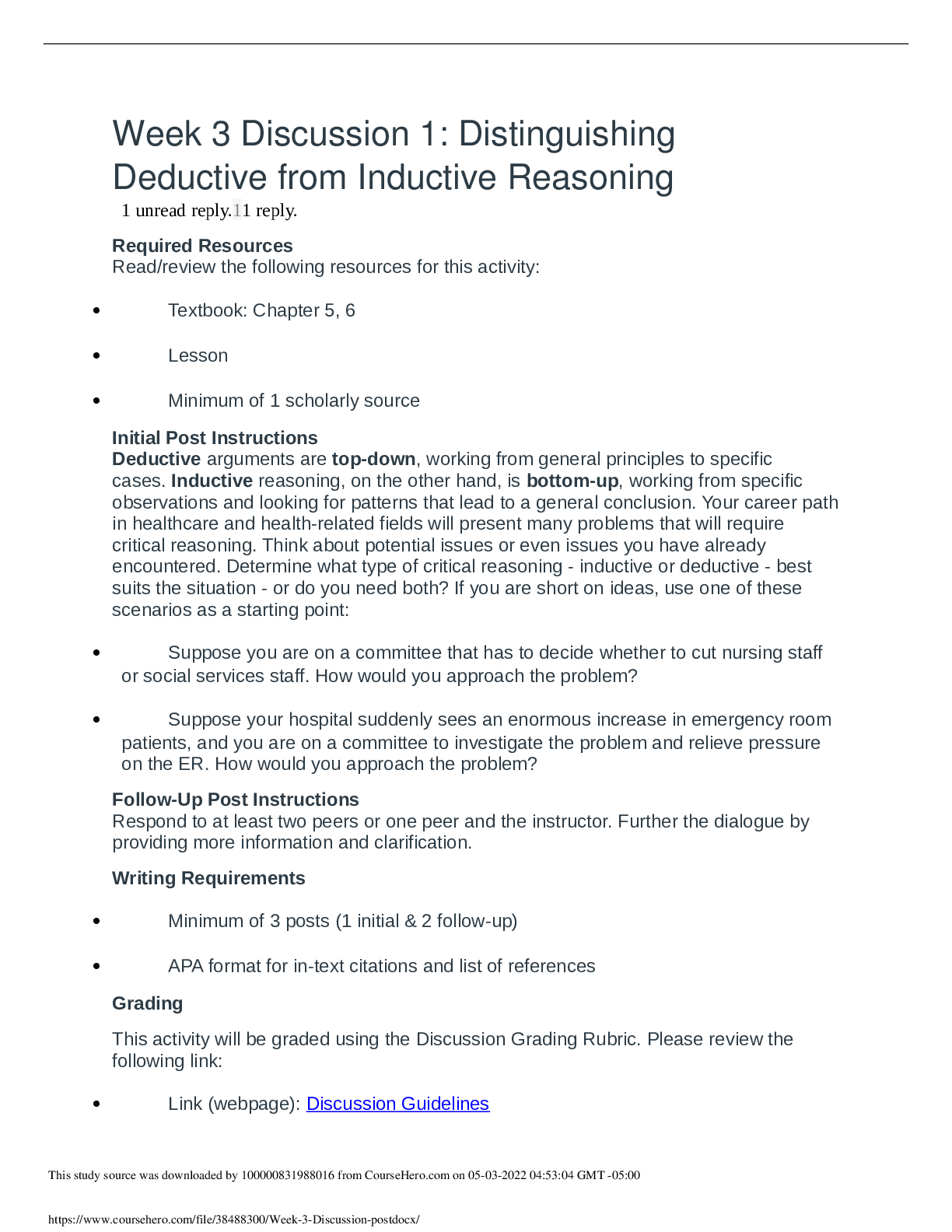

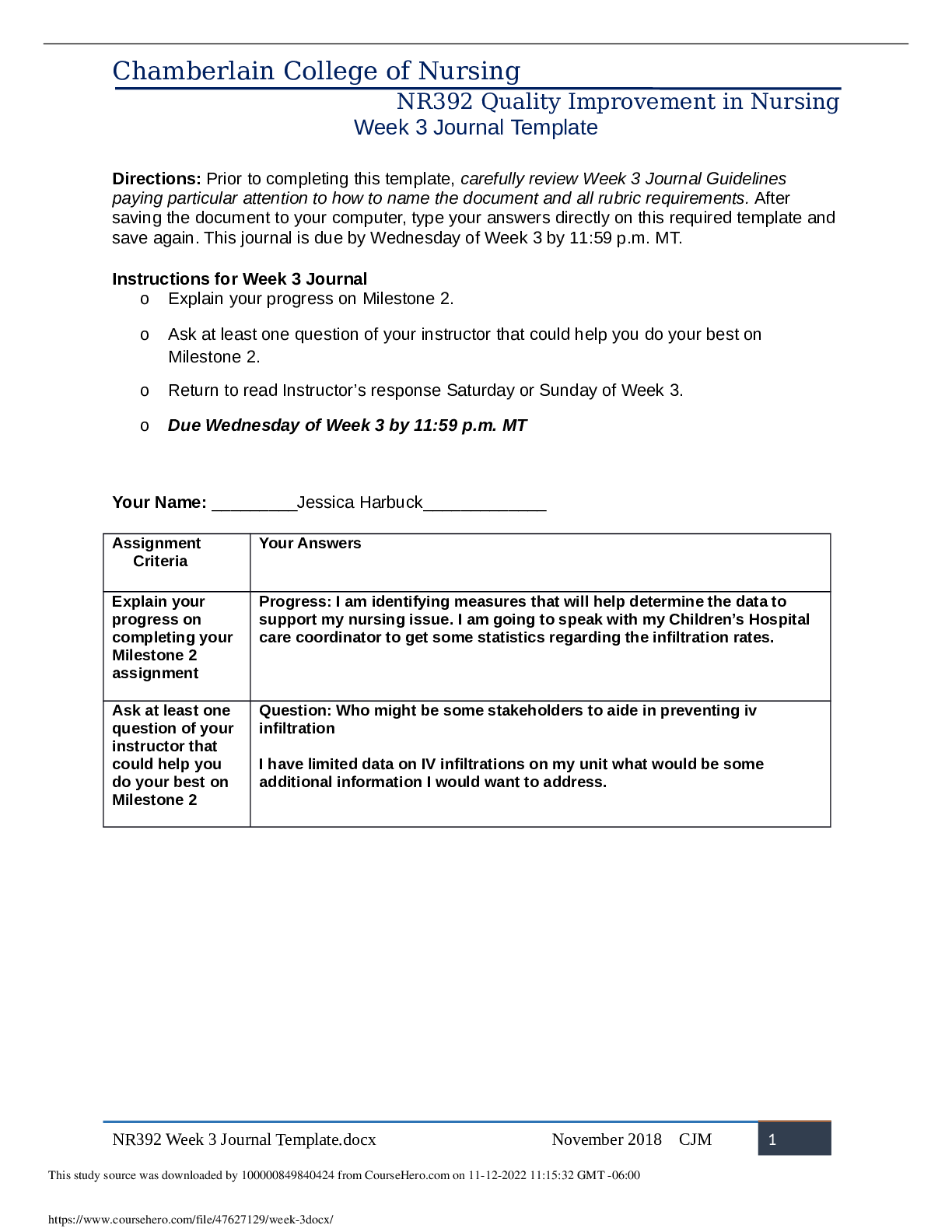

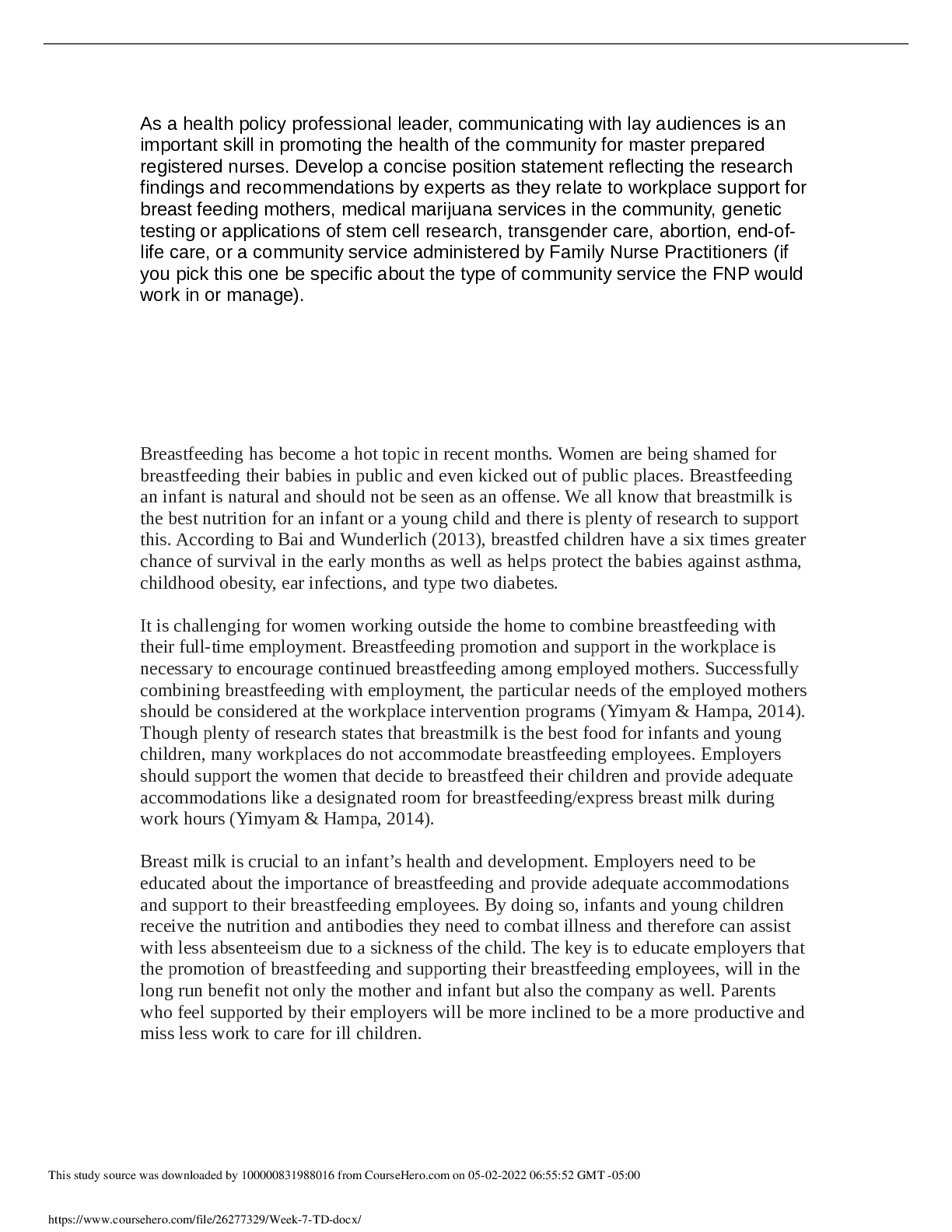

.png)

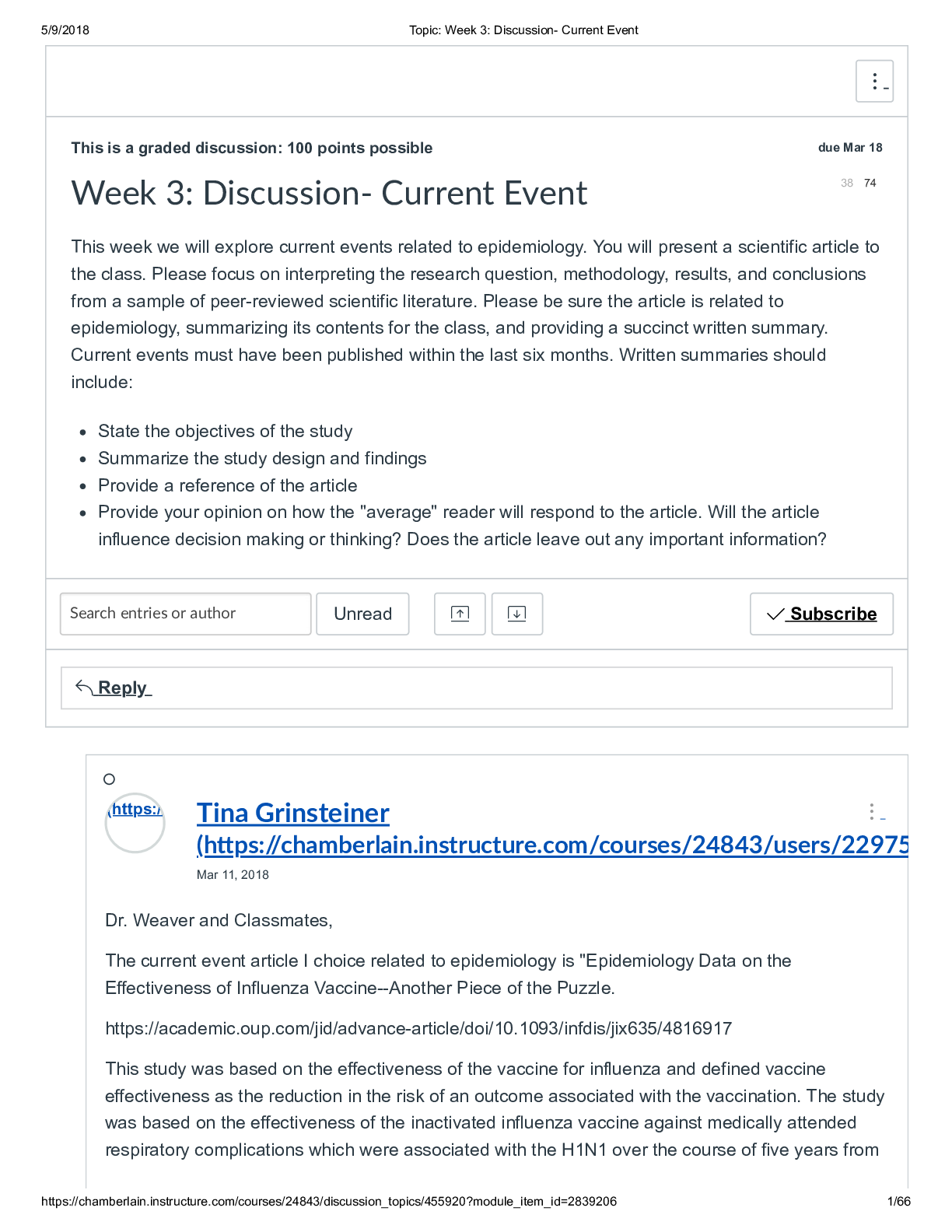

.png)

.png)
